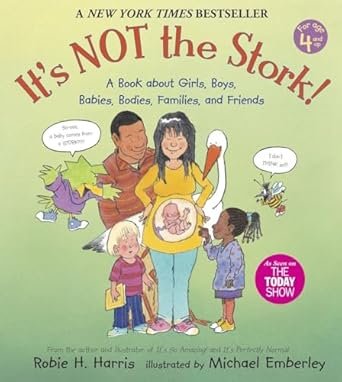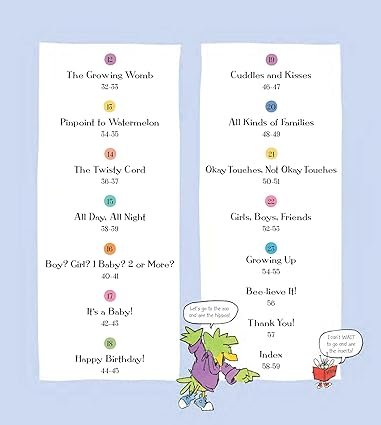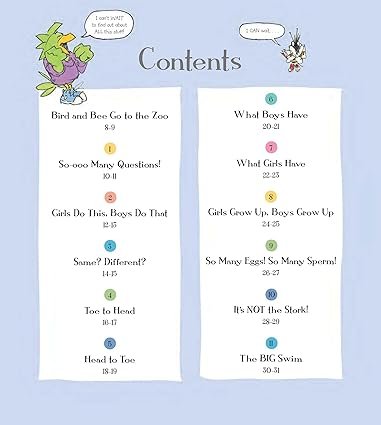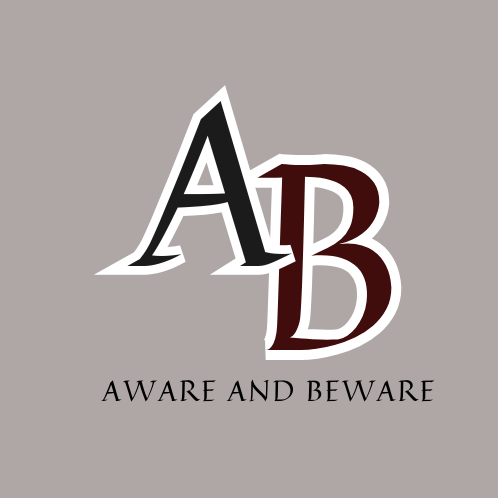1. Introduction

It’s Not the Stork! by Robie H. Harris, illustrated by Michael Emberley, is a vital book for young children (ages 4-6). It helps them understand their bodies, reproduction, and how babies are made. The book uses simple language and engaging illustrations. It answers tough questions about where babies come from and the differences between boys and girls. Additionally, it busts the myth of the stork delivering babies.
Robie H. Harris, an award-winning author known for writing about sensitive topics for young audiences, has been a pioneer in creating books on sexual health and reproduction. Her earlier works like It’s So Amazing! and It’s Perfectly Normal have already set high standards in the genre, and It’s Not the Stork! continues this tradition.
Reader Engagement: What age do you think is appropriate to start having conversations with children about where babies come from? Feel free to share your thoughts in the comments!
2. Why Should You Read This?

It’s Not the Stork! is not just another children’s book; it is an invaluable resource for parents, educators, and health professionals. The book’s biggest strength is its ability to answer difficult questions in a straightforward manner that is easy for young minds to grasp. The illustrations are playful yet informative, showing anatomical differences and explaining complex processes like pregnancy without overwhelming the child.
Today, children are exposed to many ideas through media at a young age. In this context, the book serves as an excellent tool. It provides clear, factual, and comforting information. Its child-friendly tone makes it easy for kids to understand. Moreover, the book presents scientifically accurate content. This ensures children receive answers that promote understanding, not confusion.
When compared to other books in the genre, It’s Not the Stork! stands out for its simplicity and humor. In a world where many parents are hesitant to approach these topics, this book provides an excellent starting point. Its relevance remains strong, especially as conversations about body positivity and sexual health are becoming more open.
3. Key Teachings and Themes
The book revolves around key themes such as:
– Understanding Bodies: It explains the physical differences between boys and girls and helps children appreciate the wonder of their own bodies.
– Where Babies Come From: Through gentle language, it describes the process of reproduction and pregnancy, giving kids an age-appropriate understanding.
– Challenging Myths: By humorously addressing the stork myth, the book empowers children with accurate information rather than leaving them with fanciful stories.
Notable Quotes:
1. “Some parts of girls’ and boys’ bodies are the same, and some parts are different. And that’s just the way it is.”
2. “Babies don’t come from the stork. They grow inside their mommy’s uterus before being born.”
These quotes highlight the straightforward, no-nonsense language that the author uses to address these topics.
4. How This Book Can Help You
This book can be an invaluable tool for parents who feel awkward or unsure about how to approach the subjects of bodies and reproduction with their young children. Not only does it provide accurate information, but it also encourages healthy communication between parents and children. As a parent, it can be difficult to know how to introduce these topics without overwhelming a child, but It’s Not the Stork! makes it easy by providing a framework to work from.
The book also benefits educators, counselors, and health professionals by giving them a resource that is scientifically accurate, but also sensitive and appropriate for the age group. It allows children to ask questions and feel comfortable in their bodies, helping foster a positive relationship with their own identity.
5. Writing Style and Structure
Robie H. Harris has a distinct way of using simple, accessible language without talking down to the child. The author does not sugar-coat difficult topics but approaches them with humor and sensitivity. Michael Emberley’s illustrations are colorful, friendly, and do a fantastic job of breaking down the subject matter visually, which is essential for this age group.
The book is organized into small, digestible sections. Each section focuses on one idea at a time. This allows children to explore the material at their own pace. Furthermore, the book features cartoon characters, a curious bird and a squeamish bee. These characters add fun and comic relief. As a result, the book feels less clinical and more approachable.
6. Criticism of the Book
While the book excels in many areas, some parents may feel that certain topics are introduced too early. Every child matures at a different rate, and some parents might be uncomfortable with discussing anatomy and reproduction with children as young as four or five. Additionally, the use of humorous illustrations could be seen by some as trivializing important topics.
However, this is subjective, and the book’s overall clarity and educational value outweigh these minor criticisms.
7. Why Summary Is Not Enough
Reading a summary of It’s Not the Stork! doesn’t give you the full experience of how well the book balances information, humor, and sensitivity. The nuanced language and engaging illustrations create a comforting atmosphere for children, which cannot be captured by just reading about the book’s content. Experiencing the book firsthand allows both parents and children to interact with the material at their own pace and according to their comfort level.
8. Thought-Provoking Debates
One of the ongoing debates surrounding the book is whether children as young as four or five are ready to learn about reproduction. While some believe in starting sex education early to promote body positivity and awareness, others argue that these topics should be introduced later. The book invites readers to reflect on their own beliefs and consider how they want to approach these conversations with their children.
9. Who Should Buy or Read This?
This book is ideal for parents, educators, and health professionals who work with young children. If you’re looking for an approachable, factual resource to begin conversations about bodies and reproduction, It’s Not the Stork! is an excellent choice. It can also be a great gift for new parents who want to feel prepared for when their child starts asking questions about how babies are made.
10. Reasons Not to Buy/Read
While the book is informative and engaging, it may not be a priority for parents who are not yet ready to discuss these topics with their children or for those who have already introduced similar concepts. Additionally, if you feel your child is not mature enough for these conversations, this book might be better saved for later.
11. Conclusion

It’s Not the Stork! by Robie H. Harris is an educational, thoughtful, and fun way to introduce children to important topics such as bodies, reproduction, and pregnancy. The blend of humor, clarity, and sensitivity makes it accessible for young readers while providing parents and educators with a valuable tool. Overall, the book serves as an essential starting point for conversations that many adults find challenging to navigate.
12. Final Recommendation
For parents, teachers, and health professionals seeking a resource to help explain where babies come from and other related topics, this book is a must-have. It’s perfect for starting the conversation in a straightforward yet playful way that respects a child’s curiosity.
A Thoughtful Perspective from sobersexsex.com
If you’ve found your way here through our partner site sobersextext.com, thank you for taking the time to explore this detailed review It’s Not the Stork! by Robie H. Harris.
On sobersextext.com, our team discusses important topics in sex education with a focus on addressing taboos and promoting thoughtful, respectful conversations.
The book recommended there is highlighted as a practical and meaningful tool for overcoming specific challenges in this area. Here on awareandbeware.com, we delve deeper into its features and benefits to help you decide if it’s the right fit for your needs.
If you haven’t yet, we encourage you to visit the related blog How to Provide Sex Education at Home ? It’s easy on our partner site sobersextext.com for a more nuanced perspective on how this book supports a well-informed approach to these sensitive topics.

